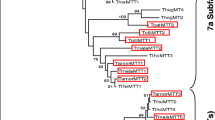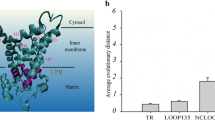Abstract
FromTetrahymena thermophila (strain BF5), the coding region ofCd-MT gene was cloned and sequenced, and identified as MTTI isoform. A serial duplicate structure is discovered in its amino acid sequence, which separates the coding region into three parts (Part 1: 7–61: Part 2: 64–118; Part 3: 122–162). The alignments among them and comparison with the corresponding parts of MT1 isoform suggest that MT1 and MTT1 isoforms both come from the same ancient gene that is homologous to Part 1, and Cd-MTs ofTetrahymena are aroused by such ancient gene duplication. The prediction of secondary structures and the analysis of the disulfide-bonding state of cysteine show that there are a lot of differences between MT1 and MTT1 isoforms, which maybe relate to their function mechanism.
Similar content being viewed by others
References
Albergoni V, Piccinni E. Copper and Zinc Metallotioneins. In: Rainsford K D Milanino R, Sorenson J R J,et al. Eds.Copper and Zinc in Inflammation and Degenerative Diseases. London: Kluwer Academic London, 1998. 61–78.
Margoshes M, Vallee B L. A Cadmium Protein From Equine Cortex.J Am Chem Soc, 1957,79:4813–4818.
Karin M, Najarian R, Haslinger A,et al. Primary Structure and Transcription of An Amplified Genetic Locus: the CUP1 Locus of Yeast.Proc Natl Acad Sci USA, 1984,81:337–341.
Snowden K C, Gardner R C. Five Genes Induced by Aluminum in Wheat (Triticum aestivum L.) Roots.Plant Physiol, 1993,103:855–861.
Mackay E A, Overnel J, Dunba B,et al. Complete Amino Acid Sequences of Five Dimeric and Four Monomeric Forms of Metallothionein from the Edible Mussel Mytilus.Eur J Biochem, 1993,218:183–194.
Schmidt C J, Hamer D H. Cloning and Sequence Analysis of Two Monkey Metallothionein cDNAs.Gene, 1983,24:137–146.
Piccinni E, Staudenmann W, Albergoni V,et al. Purification and Primary Structure of Metallothioneins Induced by Cadmium in the ProtestsTetrahymena pigmentosa andTetrahymena pyformis.Eur J Biochem, 1994,226:853–859.
Miles A T, Hawksworth G M, Beattie J H,et al. Induction, Regulation, Degradation and Biological Significance of Mammalian Metallothioneins.Crit Rev Biochem Mol Biol, 2000,35:35–70.
Binz P A, Kagi J H R. Metallothionein: Molecular Evolution and Classification.Nucleic Acid Res, 1994,22:3167–3173.
Cech T R. RNA as an Enzyme.Sci Aamer, 1986,255:64–75.
Greider C W, Blackburn E H. Identification of a Specific Telomere Terminal Transferase Activity inTetrahymena Extracts.Cell, 1985,43:405–413.
Piccinni E, Bertaggia D, Santovito G,et al. Cadmium Metallothionein Gene ofTetrahymena pigmentosa.Gene, 1999,234:51–59.
Sambrook J, Fritsch E F, Maniatis T.Molecular Cloning. 2nd Ed. New York: Cold Spring Habor Laboratory Press, 1989.
Thompson J D, Gibson T J, Plewniak F,et al. The ClustalX Windows Interface: Flexible Strategies for Multiple Sequence Alignment Aided by Quality Analysis Tools.Nucleic Acids Research, 1994,24:4876–4882.
White J V, Stultz C M, Smith T F. Protein Classification by Stochastic Modeling and Optimal Filtering of Amino-Acid Sequences.Mathematical Biosciences, 1994,119:35–75.
Fariselli P, Riccobelli P, Casadio R. Role of Evolutionary Information in Predicting the Disulfide-Bonding State of Cysteine in Proteins.Proteins, 1999,36:340–346.
Shang Y, Song X, Bowen J,et al. A robust Inducible-Repressible Promoter Greatly Facilitates Gene Knockouts, Conditional Expression, and Overexpression of Homologous and Heterologous Genes inTetrahymena thermophila.Proc Natl Acad Sci USA, 2002,99:3734–3739.
Boldrin F, Santovito G, Irato P,et al. Metal Interaction and Regulation ofTetrahymena pigmentosa Metallothionein Genes.Protist, 2002,153:283–291.
Nanney D L, Park C, Preparata R,et al. Comparison of Sequence Difference in a Variable 23S rRNA Domain among Sets of Cryptic Species of Ciliated Protozoa.J Euk Microbiol, 1998,15:91–100.
Author information
Authors and Affiliations
Corresponding authors
Additional information
Foundation item: Supported by KSCX of Chinese Academy of Sciences Grant (SW-102) and the Allocation from the Earmaarked Grant for Hong Kong.
Biography: WAN Mingliang (1980-). male, Ph. D. candidate, research direction: molecular ecotoxicology of protozoan.
Rights and permissions
About this article
Cite this article
Ming-liang, W., Wei-song, F., Wei, M. et al. Evolutionary mode of metallothioneins inferred fromCd-MT genes ofTetrahymena . Wuhan Univ. J. Nat. Sci. 10, 925–930 (2005). https://doi.org/10.1007/BF02832440
Received:
Issue Date:
DOI: https://doi.org/10.1007/BF02832440
Key words
- Tetrahymena thermophila
- metallothioneins
- evolutionary mode
- gene duplication
- protein spatial structure
- metal-binding sites




